|
Get AfricaFocus Bulletin by e-mail!
Format for print or mobile
Africa/Global: Cutting the Costs on Remittances
AfricaFocus Bulletin
May 13, 2019 (2019-05-13)
Reposted from sources cited below)
Editor's Note
“Some people use their savings to start a business, while others
turn to family and friends to borrow cash. But Ismail Ahmed’s case
was more unusual. He launched WorldRemit, a money transfer
business, with compensation cash he received after uncovering
alleged corruption at the UN. … Ahmed had waited four years since
he’d submitted the dossier alleging corruption to the UN. But the
wait proved worthwhile when in February 2010 he received £200,000
in compensation for the way he had been treated after making
allegations, the money he used to fund the launch of WorldRemit.” -
Guardian, January 20, 2017
WorldRemit grew slowly in the first few years, but since 2014 it
has attracted significant investment. And, more important, it has
built one of the most flexible and cost-effective platforms for
money transfer, particularly to African countries, and, most
recently, between African countries as well. By focusing on digital
transactions, it has provided both greater security and efficiency,
allowing senders to use credit and debit cards as well as links to
bank accounts and mobile phone apps, and receivers, depending on
the country, to get bank transfers, cash, mobile money such as
m-pesa, and mobile phone airtime payments.
I first learned of WorldRemit when trying to find a way to
contribute to a local volunteer group in Maputo, Mozambique, that
was mobilizing support for relief from the cyclone in Beira (and
now, as well, in Cabo Delgado). Using my local bank in Washington,
DC, was, I knew by experience, both very time-consuming and costly.
But signing up for WorldRemit was easy and the process quick and
not costly. I was further impressed when WorldRemit announced that
the company itself was contributing $25,000 to the Mozambican Red
Cross.
Remittances, I already knew, were rapidly growing in Africa and
around the world, surpassing official development assistance in
amounts received by development countries. But in researching this
story, I also learned, for example, that among the highest rates in
the world were between South Africa and many of its neighbors, and
was told by a friend in Johannesburg that WorldRemit was really the
only practical way she had found to send funds home to Mozambique.
[For earlier AfricaFocus Bulletins on remittances, see
http://www.africafocus.org/docs14/remi1404.php and
http://www.africafocus.org/docs15/som1502.php]
Thus, this Bulletin, which includes an email interview with a
South-Africa-based representative of WorldRemit, as well as
additional background and excerpts from the most recent World Bank
report on remittances. The most striking statistic is that average
costs for remittances worldwide are at 7%, and for sub-Saharan
Africa 9%. Targets for supporting development are 3%, but costly
and inconvenient transfers through banks, Western Union, and other
transfer agents keep the price up. In country after country,
World Remit shows up with the lowest or next-to-lowest rates among
providers, as one can check in on-line databases such as
https://www.monito.com/ or, for a
smaller number of countries, https://remittanceprices.worldbank.org/en.
Review of WorldRemit
https://www.monito.com/en/send-money-with/worldremit
WorldRemit is also aggressively pursuing new customers. And if you
use this link (https://www.worldremit.com/en/r/WILLIAMM1241) to
sign up, and send an initial transfer of $100 or more, both you and
AfricaFocus get a discount of $20 on a future transfer. For my
part, I will use my discounts for future contributions to local
recovery efforts in Mozambique.
If you do use WorldRemit, or have experiences with other companies
that you think are as good or even better for transferring funds to
family or friends in African countries, please share your thoughts
with me by email at africafocus@igc.org
For previous AfricaFocus Bulletins on the economy and development,
visit http://www.africafocus.org/econexp.php For previous
AfricaFocus Bulletins on migration and related issues, visit
http://www.africafocus.org/migrexp.php
++++++++++++++++++++++end editor's note+++++++++++++++++
Interview by Email with WorldRemit
May 2, 2019
Many thanks to Akinyi Ochieng, Corporate Communications Manager for
WorldRemit, based in London, for arranging this interview. Ms.
Ochieng is also a prolific writer on a wide range of Africa-related
topics (http://www.akinyiochieng.com/). The questions below were
answered by Andrew Stewart, Managing Director, Middle East and
Africa, based in WorldRemit´s Johannesburg office.
AF (AfricaFocus): Can you tell me in a few paragraphs what are the
main reasons WorldRemit was needed as an alternative to Western
Union and other large companies, and why you think it is making a
contribution to African development?
WR (WorldRemit): WorldRemit is a leader in the move from offline to
digital money transfers. Along with the convenience this brings,
our cashless model on the sending side makes us more secure and
provides a digital footprint to deal with global compliance
requirements.
Africa is WorldRemit’s largest market, and we are currently present
in over 40 African markets and are expanding rapidly, driven by key
partnerships with local correspondents, our low fees, and our
mobile-first approach. We have regional offices in Senegal, Egypt,
Kenya, Tanzania, Uganda, Ethiopia, and South Africa. As Africa is
our largest market globally we are keen to continue expanding our
operations across the region.
According to the World Bank, remittances to sub-Saharan Africa grew
to $37.8 billion in 2017, according to the World Bank and are
forecast to hit around $39.2 billion for 2018 and $39.6 billion in
2019. WorldRemit is ensuring that Africans in the diaspora can make
the most of the opportunities they have and send a greater share of
their money home. Our recent research
(http://educationmatters.worldremit.com) shows that if all
remittances globally were sent digitally, it could unlock $825m for
education worldwide--a shift that would have an outsize effect in
Africa, which is home to large numbers of out-of-school children.
AF: Can you expand on the obstacles to lowering the high cost of
remittances to Africa, and how WorldRemit can afford to offer lower
rates?
WR: The vast majority of remittances today are still sent offline
at corner shops and bricks-and-mortar money transfer agents. People
in the diaspora have to find the time in their busy lives (many
working multiple jobs), to visit a money transfer agent during
business hours and then pay extortionate fees to send money home.
However our cashless model significantly reduces cost on the
sending/pay-in side as well as providing convenience.
For example, South Africa is the most expensive G20 country to send
money from with an average cost of over 15% for sending $200 - more
than double the global average (https://remittanceprices.worldbank.org/ - direct URL:
http://tinyurl.com/yxfsysfq). In Zimbabwe and Mozambique, two of
the top remittance destinations from South Africa, however,
WorldRemit fees are below 4% of the transaction cost on average.
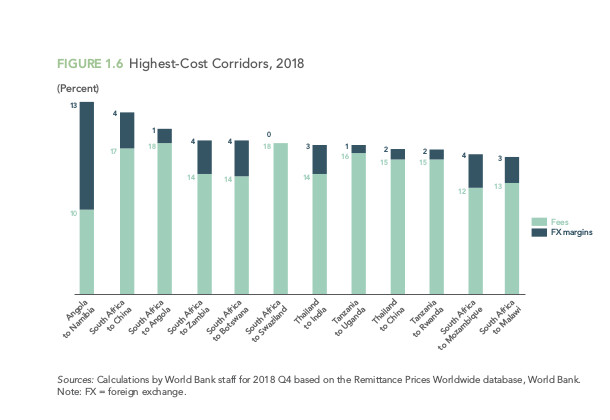
AF: How many countries in Africa can one send remittances to
through WorldRemit?
WR: You can reach over 40 countries across the continent, including
Ghana, Kenya, Nigeria, Zimbabwe, and more. Most of our customers
choose to send via smartphone, and over 90% of all transactions are
authorized in less than 10 minutes.
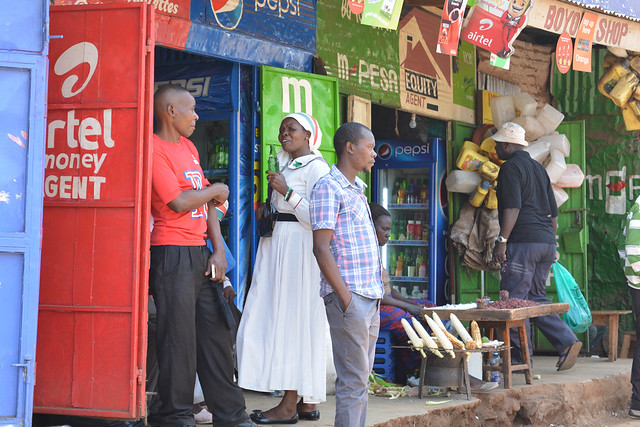
Sunday morning in Nairobi Credit: Fiona Graham / WorldRemit.
AF: I first learned of WorldRemit through trying to find a way to
send funds to Mozambique for Cyclone Idai, and I later saw that
WorldRemit itself contributed $25,000. Do you have statistics on
how many people sent funds to people or organizations in the
affected countries through WorldRemit in the weeks after the
Cyclone hit Mozambique, Zimbabwe, and Malawi?
WR: The flow of remittances is 3 times bigger than official
development aid, but in the West we often only talk about the aid
given by donor countries. When a natural disaster occurs, or in
times of economic or political upheaval, remittances - the money
sent by a resident of one country to a person elsewhere in the
world - can provide immediate financial assistance to those who
need it most. Remittance flows are a significant source of income
flowing directly into people’s household incomes, while also
supporting broader development goals.
Unfortunately we don’t have statistics on this as relates to
Cyclone Idai, but to maximise the diaspora’s contributions to their
communities back home in times of urgent need, we have set up
donation matching schemes to the Red Cross. In September 2018, in
the wake of Typhoon Mangkhut, we matched donations made through our
service to the Philippines Red Cross. In October, we matched
donations to the Indonesian Red Cross after the devastating
earthquake and tsunami.
AF: What are your projections of growth for WorldRemit in terms of
market percentage compared to companies such as Western Union?
WR: Of the $700 billion dollars that are sent by migrants every
year, the majority are still sent in cash over the counter or at
high street agents. Western Union and MoneyGram – two of the
biggest names in the industry – account for less than 20% of market
share and a growing share is moving online. The arrival of digital
technology means more people are sending large sums of money
through cheaper and more secure methods such as WorldRemit, and the
number of people sending is also projected to grow due to the rapid
rise in the number of migrants from 173 million
(http://tinyurl.com/y53joqgk) to nearly 250 million
(http://tinyurl.com/y9bz22z5) in the last 20 years.
AF: Given how much cheaper World Remit seems to be over other
transfer mechanisms, what are some of the barriers you have to
overcome to reach more people?
WR: WorldRemit has launched inter-African payments, enabling
customers in Africa to send as well as receive money transfers to
145 markets. To do this, we are getting licenses for receive
countries to become send countries: we recently launched Somaliland
and South Africa as send countries. This is especially important
from the point of view of customers sending within Africa, because
Sub-Saharan Africa remains the most expensive regions to send
remittances to, with an average cost of 9.4 percent
(http://tinyurl.com/ycxlwuxk) for sending $200, according to the
World Bank. This is part of our vision to stimulate growth and
trade within the continent, led by a cashless model. In each new
sending country, WorldRemit must secure local licenses but as we
secure these in more African countries we’ll be poised to tap into
the future of growth across the Global South.
AF: What measures do you take to avoid the use of WorldRemit for
money laundering, and to identify and screen out suspicious
transactions?
WR: The need for alternatives to offline, agent-based money
transfers is growing in large part due to fraud risks, high costs
and inconvenience. Consider the challenges in this process – you
stand in line at an agent store, fill out paper forms and hand over
your payment in cash. The potential for human error is vast and it
takes months before the paper trail is put together and potential
fraud can be investigated. Online money transfers can mitigate
against some of the risks involved with cash-based remittances. The
electronic footprint online transfers leave acts as a strong
deterrent to criminal groups. Beyond fraud, online money transfers
can improve speed and convenience for users, as well as lowering
costs.
When we started back in 2010, we were one of the first businesses
to set up an entirely online remittance service. We determined that
the only way to meaningfully reduce the challenges of money
laundering and terrorist financing was to bring remittances out of
the traditional cash and paper-based models and into the online
world.
As compliance is an inherent part of our platform, we have spent
time and capital building our digital compliance system. We have
developed a sophisticated model supported by machine learning with
multiple stages of identity checks.
Emma Featherstone, Interview with WorldRemit founder Ismail Ahmed
Guardian, Jan. 20, 2017
[Excerpt only. Full article at http://tinyurl.com/he9caeb]
Some people use their savings to start a business, while others
turn to family and friends to borrow cash. But Ismail Ahmed’s case
was more unusual. He launched WorldRemit, a money transfer
business, with compensation cash he received after uncovering
alleged corruption at the UN.
Ahmed, who grew up in Somaliland, a breakaway part-desert territory
that declared independence from Somalia in 1991, became interested
in the money transfer industry after realising how many people
relied on it. Studying economics in the UK he learned the
industry’s nuances.
He then helped to run a money transfer project as part of the
United Nations Development Programme (UNDP), aiming to make a
positive difference in a sector that’s vulnerable to crime. But
Ahmed discovered alleged corruption in the UN’s Somalia remittance
programme and confronted his boss. “My boss said if I went and
submitted the dossier, I would never be able to work in remittances
again, and I took that threat very seriously. I lost my job to
uncover the fraud.”
Undeterred by the spectre of a ruined professional reputation, and
having left the UN, Ahmed set about realising his ambition to start
a mobile money transfer business. “While I was fighting for [my
case] at the UN, I was also studying at the London Business
School.”
During this time, he came up with a business plan for WorldRemit,
which was first launched as AfricaRemit. It would offer a service
for migrant workers to send money to countries across the world
using just a smartphone and app. The service would cut out the
middleman – the agents needed to deal out the money.
By December 2009 Ahmed was ready to register the business. So it
was timely that in the same month he was notified of the UN’s
decision: “I received the letter from the UN ethics committee mid-December
and a few days later I incorporated the company.”
Ahmed had waited four years since he’d submitted the dossier
alleging corruption to the UN. But the wait proved worthwhile when
in February 2010 he received £200,000 in compensation for the way
he had been treated after making allegations, the money he used to
fund the launch of WorldRemit.
More at http://tinyurl.com/he9caeb
Migration and Remittances: Recent Developments and Outlook
Migration and Development Brief 31
World Bank, April 2019
http://tinyurl.com/y4aajnsj
Summary
This Migration and Development Brief provides updates on global
trends in migration and remittances and validates the projections
made in the previous Brief in December 2018. It highlights
developments related to migration-related Sustainable Development
Goal (SDG) indicators for which the World Bank is a custodian:
increasing the volume of remittances as a percentage of gross
domestic product (GDP) (SDG indicator 17.3.2), reducing remittance
costs (SDG indicator 10.c.1), and reducing recruitment costs for
migrant workers (SDG indicator 10.7.1). It also presents recent
developments on the Global Compact on Migration (GCM).
Remittance trends.
In 2019, annual remittance flows to low- and middle-income
countries (LMICs) are likely to reach $550 billion. That would make
remittance flows larger than foreign direct investment (FDI) and
official development assistance (ODA) flows to LMICs. In 2018,
remittance flows to LMICs reached $529 billion, an increase of 9.6
percent over 2017. Remittance flows grew in all six regions,
particularly in South Asia (12.3 percent) and Europe and Central
Asia (11.2 percent). Growth was driven by a stronger economy and
employment situation in the United States and a rebound in outward
flows from some Gulf Cooperation Council (GCC) countries and the
Russian Federation.
Remittance costs.
The global average cost of sending remittances remained at about 7
percent in the first quarter of 2019, roughly the same level as in
recent quarters, according to the World Bank’s Remittance Prices
Worldwide database. The cost of sending money to Sub-Saharan Africa
was 9.3 percent, significantly higher than the SDG target of 3
percent. Banks were the costliest channel for transferring
remittances, at an average cost of 10.9 percent. De-risking by
international correspondent banks—that is, the closing of bank
accounts of money transfer operators (MTOs) to avoid rather than
manage the risk in their efforts to comply with anti–money
laundering and countering financing of terrorism (AML/CFT)
norms—has affected remittance services and may have prevented
further reduction in costs.
Also, in an apparent example of policy incoherence, remittance
costs tend to include a premium, that is a cost mark-up, when
national post offices have exclusive partnership arrangements with
a dominant MTO. This premium averages 1.5 percent of the cost of
transferring remittances worldwide and is as high as 4.4 percent in
the case of India, the largest recipient of remittances. Opening up
national post offices, national banks, and telecommunications
companies to partnerships with other MTOs could remove entry
barriers and increase competition in remittance markets.
…
1.Global Remittance Flows and Migration-Related Sustainable
Development Goals
1.1 Remittances Accelerated in 2018
Remittance flows to low- and middle-income countries (LMICs) grew
by 9.6 percent in 2018 (up from the 8.8 percent rise in 2017), to
reach a record $529 billion (table 1.1 and figure 1.1a). The rise
in remittances was driven by higher growth in the United States and
a rebound in remittances outflows from some Gulf Cooperation
Council (GCC) countries and the Russian Federation.
Remittances are now the largest source of foreign exchange earnings
in the LMICs excluding China. They are more than three times the
size of official development assistance (ODA). Moreover, since
foreign direct investment (FDI) has been on a downward trend in
recent years, remittances reached close to the level of FDI flows
in 2018. Excluding China, remittances were significantly larger
than FDI flows (figure 1.1b).
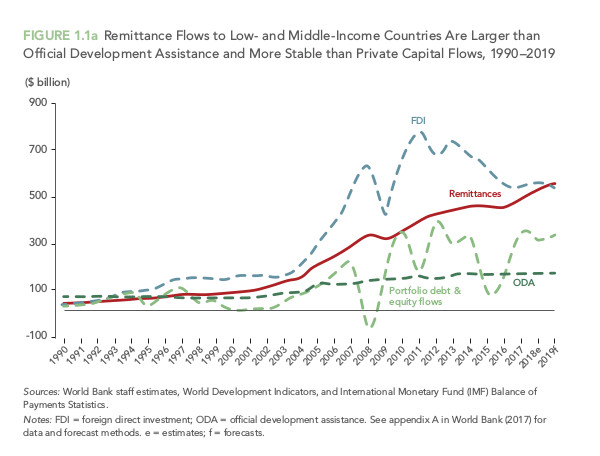
…
3.6 Remittances to Sub-Saharan Africa Continued to Accelerate in
2018
Remittance trends.
Remittances to Sub-Saharan Africa were estimated to grow by 9.6
percent from $42 billion in 2017 to $46 billion in 2018.
Projections indicate that remittances to the region will keep
increasing, but at a lower rate, to $48 billion by 2019 and to $51
billion by 2020. The upward trend observed since 2016 is explained
by strong economic conditions in the high-income economies where
many Sub-Saharan African migrants earn their income.
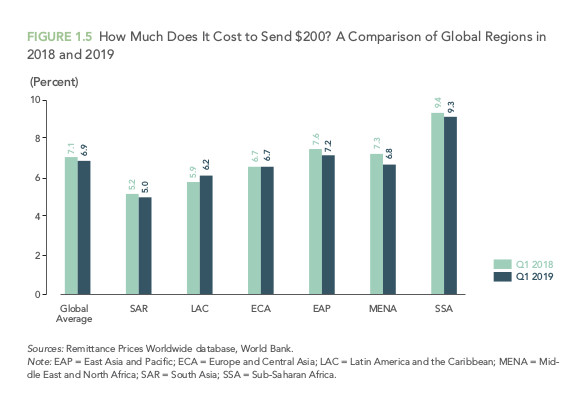
Nigeria, the largest remittance-recipient country in Sub-Saharan
Africa and the sixth largest among LMICs, received more than $24.3
billion in official remittances in 2018, an increase of more than
$2 billion compared with the previous year (figure 3.11). Looking
at remittances as a share of GDP, Comoros has the largest share,
followed by the Gambia, Lesotho, Cabo Verde, Liberia, Zimbabwe,
Senegal, Togo, Ghana, and Nigeria.
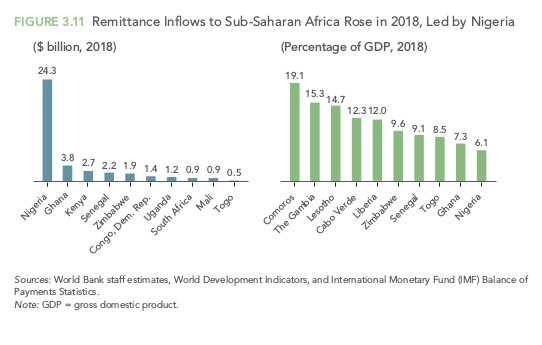
Remittance costs.
The cost of sending $200 to the Sub-Saharan African region averaged
9 percent in 2018 Q4, almost the same as in 2018 Q3. A slight
declining trend has been observed in remittance costs in the region
since the beginning of 2018, but this remains far above the global
average of 7 percent and the SDG target of 3 percent to be achieved
by 2030.
Moreover, the regional average hides country-level variations. For
instance, in 2018, for the cheapest corridors it costs on average
3.5 percent, an amount close to the SDG 3 percent target (figure
3.12). On the other hand, for the five most expensive corridors,
mainly in the southern African subregion, the average cost was 18.7
percent, almost three times higher than the global average and six
times higher than the SDG target. The most expensive corridor
(Angola-Namibia), saw significant variation in fees from 15.8 to
22.4 percent between 2018 Q3 and 2018 Q4. This indicates that
efforts are needed to address high intraregional transaction costs
in the remittance-transmission industry.
AfricaFocus Bulletin is an independent electronic publication
providing reposted commentary and analysis on African issues, with
a particular focus on U.S. and international policies. AfricaFocus
Bulletin is edited by William Minter.
AfricaFocus Bulletin can be reached at africafocus@igc.org. Please
write to this address to suggest material for inclusion. For more
information about reposted material, please contact directly the
original source mentioned. For a full archive and other resources,
see http://www.africafocus.org
|
